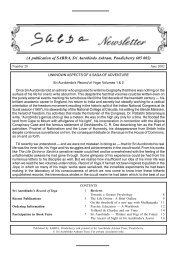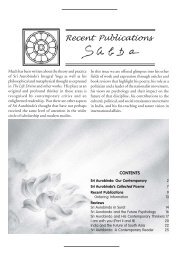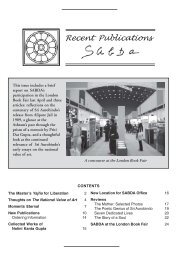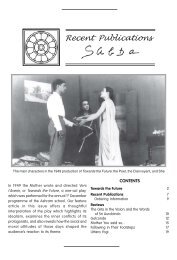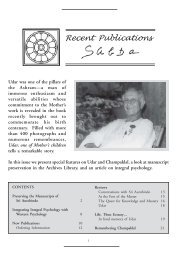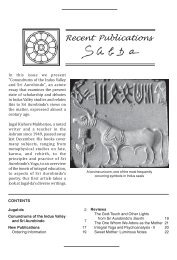Recent Publications - Sabda - Sri Aurobindo Ashram
Recent Publications - Sabda - Sri Aurobindo Ashram
Recent Publications - Sabda - Sri Aurobindo Ashram
You also want an ePaper? Increase the reach of your titles
YUMPU automatically turns print PDFs into web optimized ePapers that Google loves.
6 <strong>Recent</strong> <strong>Publications</strong><br />
Just behind the mansion is the house where the Bande<br />
Mataram office was located. It was part of a series<br />
of houses which belonged to the same property;<br />
perhaps it was meant for distant relatives. A very<br />
narrow, virtually private lane separates the mansion<br />
from this block of more modest houses. One can<br />
even now see the back gate of the<br />
mansion almost facing what used to<br />
be the front door of the office, thereby<br />
suggesting that people could go easily<br />
from one house to the other. Although<br />
the paper had been started by Bepin<br />
Chandra Pal it was Subodh Mullick and<br />
his cousin Nirod Mullick who were its<br />
chief financial supporters. They had<br />
even given the place for housing the<br />
office.<br />
A little door in a narrow lane—this is all<br />
one can see today. But it was from<br />
this tiny office, a hundred years ago,<br />
that the call for revolution had gone<br />
out. From here started the fire that<br />
was to rage all over Bengal. The work<br />
of waking India from her tamas was<br />
done from this tiny lane. Page after<br />
page of stirring prose came out from<br />
here, written in English, in a style which<br />
had both lucidity of mind and intensity<br />
of feelings. These words would provoke<br />
the British, arrests would be made,<br />
some would be trapped in prisons, and others would<br />
walk unwavering to the gallows. A nation would rise<br />
up and fight for its rights.<br />
Who was Subodh Mullick and how closely was he<br />
associated with <strong>Sri</strong> <strong>Aurobindo</strong>? He came from a<br />
wealthy family which owned vast properties. Subodh<br />
Chandra Mullick was<br />
not really a “raja”<br />
(king). It was a title<br />
given to him by the<br />
people, owing not<br />
only to his vast<br />
wealth but also to<br />
his generosity. He<br />
had donated a sum<br />
of one lakh rupees<br />
to the National<br />
College at Kolkata, of which <strong>Sri</strong> <strong>Aurobindo</strong> was the<br />
first Principal. It is popularly believed that the title<br />
“raja” might have been affixed to his name after<br />
this act of generosity. What that sum represented a<br />
hundred years ago can only be imagined from the<br />
way it impressed the people.<br />
Subodh Mullick had studied at Presidency College<br />
and later had run away to England to join Trinity<br />
College at Cambridge. Apparently he never took a<br />
degree from the University since he left without<br />
completing his studies. He may even have made an<br />
effort at studying law while he was in England. Perhaps<br />
this common background<br />
brought him closer to <strong>Sri</strong><br />
<strong>Aurobindo</strong>.<br />
Not only did he give his full<br />
support, morally and<br />
financially, but he was also a<br />
political associate. So much<br />
so that after <strong>Sri</strong> <strong>Aurobindo</strong><br />
was arrested in Kolkata on 2 nd<br />
May 1908, Subodh Mullick’s<br />
other house in Varanasi was<br />
searched by the police on 8 th<br />
May. Then two days later, on<br />
10 th May, while the Mullick<br />
family was away at Varanasi<br />
the police searched this<br />
beautiful house in Kolkata and<br />
turned it upside down in their<br />
effort to get hold of any<br />
incriminating documents. The<br />
police knew very well that<br />
Subodh Mullick had made his<br />
mansion in Wellington Square<br />
the centre of political activities<br />
headed by <strong>Sri</strong> <strong>Aurobindo</strong>. Meetings were held there<br />
and important decisions were taken. Few people<br />
know that he too was arrested and jailed in Almora<br />
for fourteen months. After his release in February<br />
1910 when he returned to his Wellington Square<br />
mansion, <strong>Sri</strong> <strong>Aurobindo</strong> paid him a visit. It was the<br />
last time they ever saw each other.<br />
Commemorative marble plaque next to the<br />
main gate of Subodh Mullick’s mansion.<br />
Just behind the mansion at 12 Wellington<br />
Square is the house where the Bande Mataram<br />
office was located. A little door in a narrow<br />
lane—this is all one can see today. But it was<br />
from this tiny office, a hundred years ago,<br />
that the call for revolution had gone out.<br />
Today this historic building<br />
stands in faded splendour, a<br />
reminder of the days when<br />
the entire nation was inspired<br />
to sacrifice so much. The<br />
country has not forgotten<br />
Raja Subodh Chandra<br />
Mullick. There is a park in<br />
Kolkata named after him as<br />
well as a road, and even<br />
Wellington Square has been renamed in his honour.<br />
He was a man who had lived a life of luxury befitting<br />
a king and yet was prepared to face hardships and<br />
even imprisonment for upholding his beliefs and<br />
asking the freedom of his country.<br />
— Sunayana Panda



